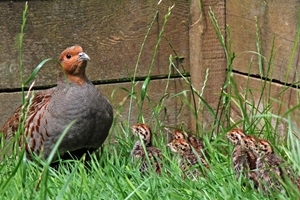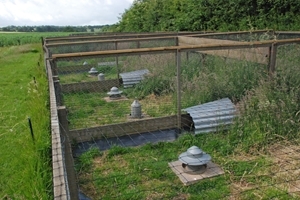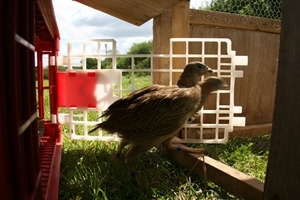 Parent-reared birds (i.e. grey partridge juveniles hatched and reared by a pair of grey partridges) should be favoured, followed by bantam or artificially reared ones. If used for fostering, leave the parent birds with a minimum of two juveniles. Use them, for example, to keep your breeding stock going.
Parent-reared birds (i.e. grey partridge juveniles hatched and reared by a pair of grey partridges) should be favoured, followed by bantam or artificially reared ones. If used for fostering, leave the parent birds with a minimum of two juveniles. Use them, for example, to keep your breeding stock going.
Parent rearing
Parent-reared birds can either be used for autumn release of entire family groups or for fostering juveniles to barren wild pairs.
Tip 1. Obtain pairs from a mixed-sex flock kept over winter.
- Over-winter a mixed-sex flock of greys in a large holding pen until mid-March (for 100 birds use a 120x80-foot pen). The holding pen must contain plenty of sight barriers and other structures (e.g. brashings) to offer shelter and minimise feather pecking and aggression. The holding pen should be divided into several sections (connected with doors or pop holes) including 10x10-foot pens in the corners. Allow ‘natural’ pairing in spring as this improves partner bond. Pairs tend to settle in the 10x10-foot pen sections where they can easily be caught.
- Transfer established pairs to fresh 20x10-foot pens in March.
 Tip 2. Keep pairs in 20x10-foot pens, divided into two halves and connected with a pop hole or door.
Tip 2. Keep pairs in 20x10-foot pens, divided into two halves and connected with a pop hole or door.
- One half of the pen should consist of short grass, a feeder, grit and a drinker, whereas the other half should be old tussocky grass including brashings for nesting cover.
- Ensure that parasites are controlled during this time. Allowing infection in adult birds merely seeds the pen for the infection of vulnerable chicks at a later date.
Tip 3. Minimise disturbance.
- Once the hen is sitting tight, do not disturb her. Only check her water and food.
- On average the chicks will hatch after 23 days.
Tip 4. Once the chicks have hatched, provide adequate food and water.
- The first two weeks after hatching are the most crucial ones and parasites are usually the main cause of chick loss. Discuss parasite control with your vet.
- In addition to the partridge crumbs and ground feed mixture, try to provide natural food such as ant pupae (eggs). An upturned plant pot, for example, is likely to attract an ant’s nest where ants are present. Remove the pot when the chicks arrive to allow the birds access to the nest.
Rearing under bantams
Tip 1. House broody bantams in a fully enclosed 3 x 6-foot wooden ark, attached to a 10x10-foot mown-grass pen.
- The ark should have a covered 3x3-foot nesting area and a 3x3-foot grass run.
- The ark should be connected with the pen through a pop hole.
Tip 2. Let a broody bantam incubate the partridge eggs herself, or incubate the eggs artificially for 21 days and return under the bantam for the last two to three days before hatching.
- Allow the bantam to continue sitting on artificial eggs.
- After 21 days swap the artificial eggs with the incubated partridge eggs, allowing the bantam to hatch her ‘own’ chicks. Additionally, a small sample of eggs can be hatched in the incubator to supplement any hatch failures in individual broods immediately after hatching.
- Following hatching, the broods should be retained for up to seven days within the ark’s enclosed nesting area, depending on the prevailing weather conditions.
- After one week, release the family group into the whole ark.
- When they are sufficiently grown, and during good weather conditions, allow the birds access to the larger grass pen.
Artificial rearing
Obtain chicks from a game farm, for example, and rear them using standard brooder house methods (see our Green guide for rearing).
Tip 1. Allow poults to form a sibling bond.
- At an age of five weeks, catch up coveys of 13-17 individuals from the main group and hold them separately in a 10x10-foot pen for one week to allow the poults to form a bond. Make sure that their appropriate release age coincides with early August.
Family groups for autumn release
Ideally, release parent-reared juveniles together with their natural parents (see also parent-rearing). Alternatively, either rear the chicks artificially and then foster them to their natural parents, or create an unrelated family group using bantam or artificially reared juveniles fostered to an ex-laying or captive barren pair.
If the family group is created artificially:
Tip 1. Keep adult pairs in a divided 20 x 10-foot pen until fostering time.
- Keep the adult pair in one side of the pen as this helps maintain a low parasite level in the remaining side where the chicks will be placed.
- Replace the eggs of the grey partridge female with dummy eggs to ensure that she remains broody. Incubate and hatch the partridge eggs either artificially or under a bantam.
Tip 2. Foster poults at an age of three weeks to a barren captive-held pair.
 As fostering time approaches (early July to mid-August, with earlier dates preferred), add 13-17 poults to the side of the 20x10-foot pen that has not been in use so far. Do this in the early morning on a sunny day, ideally during a spell of settled weather with no cold nights or rain forecast to allow final hardening of the poults. Allow the poults an hour or two to settle into their new pen before lifting the pop hole dividing the two pens, allowing adults and chicks to mingle. Observe birds discretely from a distance, as some aggression from one or both adult birds may occur. There is no telling when and if this is going to happen, and in most cases aggressive behaviour settles within an hour or two.
As fostering time approaches (early July to mid-August, with earlier dates preferred), add 13-17 poults to the side of the 20x10-foot pen that has not been in use so far. Do this in the early morning on a sunny day, ideally during a spell of settled weather with no cold nights or rain forecast to allow final hardening of the poults. Allow the poults an hour or two to settle into their new pen before lifting the pop hole dividing the two pens, allowing adults and chicks to mingle. Observe birds discretely from a distance, as some aggression from one or both adult birds may occur. There is no telling when and if this is going to happen, and in most cases aggressive behaviour settles within an hour or two.- If aggressive behaviour of adults is overt, it is usually from one of the two, but rarely both. Separate the aggressive bird by moving it to the half of the pen opposite the one where it was originally kept, and leave the chicks with the other adult in the other half. Moving the aggressive adult to the half of the pen it has not previously used reduces its territorial behaviour. In 99% of cases the chicks will calm down with the tolerant adult. Allow the separated adult to merge with the fostered group after 24 hours. By that time, it will usually have lost its aggressive behaviour.
Tip 3. Keep the fostered family in captivity until early October.
- Allow the fostered group to use both parts of the 20x10-foot pen until ready for release.
- Release the covey as described elsewhere in these guidelines.
Get the Latest News & Advice
Join over 100,000 subscribers and stay updated on our latest advice, research, news and offers.
*You may change your mind any time. For more information, see our Privacy Policy.